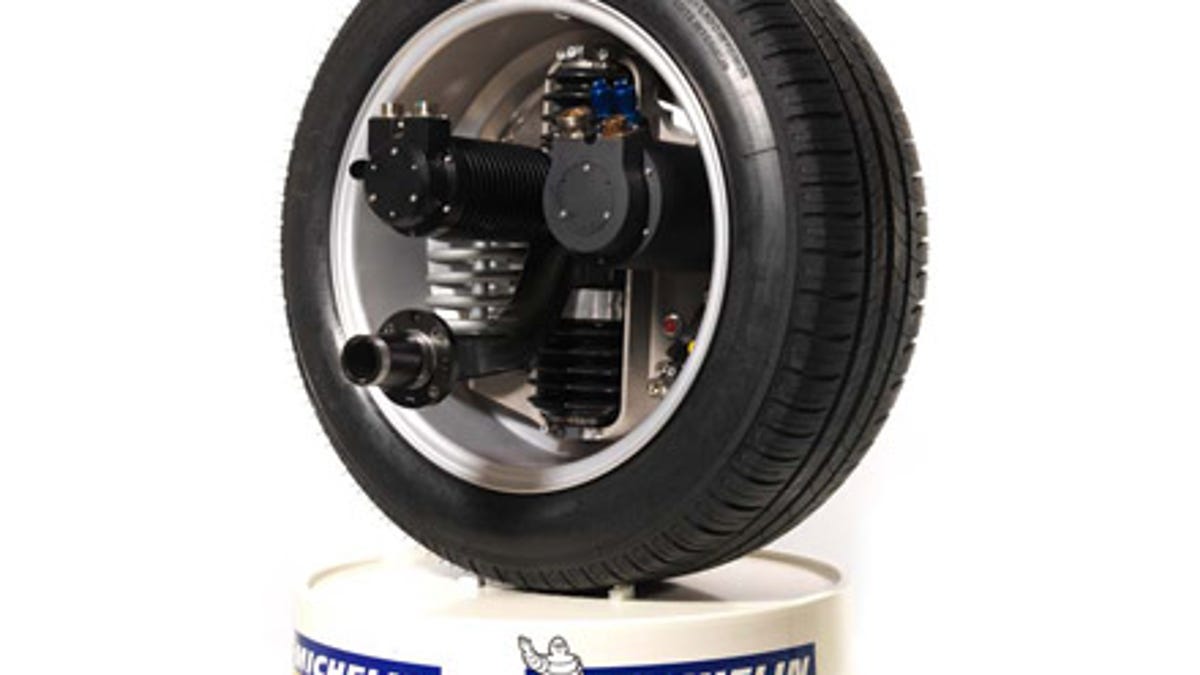Michelin moves the motor to the tyre
It might sound counter-intuitive but if the future of the car is electric, then we could well see the motor move from the front of the car to the wheels. Well, that's what Michelin, Heuliez and Orange have in mind.

Paris Motor Show 2008 It might sound counter-intuitive but if the future of the car is electric, then we could well see the motor move from the front of the car to the wheels. Well, that's what Michelin, Heuliez and Orange have in mind.
Issues with battery tech aside, electric motors allow for the creation of much simpler vehicles, without the need for exhausts, cooling systems, or complex lubrication schemes. The next logical step for electric vehicles is to move the electric motors into the wheel hubs themselves, replacing driveshafts, transmissions, and differentials with a much lighter set of wires and switches. The primary problem with this configuration is the huge jump in unsprung weight — basically sprung weight is the everything carried by the suspension, so unsprung weight is the weight of the wheels, tyres, suspension and, possibly, the brakes — that comes with mounting heavy electric motors inside of the wheels. Michelin thinks it may be a step closer to solving this problem with its Active Wheel technology, unveiled at the 2008 Paris Motor Show.
The Active Wheel system consists of the wheel and tyre combination, an electric motor, an active suspension system, and disc braking system all integrated into a 43kg package. Essentially, every element of the powertrain and suspension has been compacted. Smaller 6.5kg electric motors can be used because there will be two to four of them sharing the load. Use of an electronically controlled active suspension system allows for a smaller, shorter travel suspension that can be optimised for road conditions.
The Heuliez Will is, basically, an Opel/Vauxhall Agila fitted with Michelin Active Wheels
Photo credit: Michelin
The Heuliez Will — a prototype based on the European-market Vauxhall/Opel Agila — has been built in a partnership between Michelin, coachbuilder Heuliez, and the telecommunications company Orange. This front-wheel drive prototype features an unsprung weight of 35kg per wheel on the front axle and 24kg per wheel on the rear axle, thanks to the omission of rear wheel motors. Michelin points out that a conventional but similarly sized Renault Clio features an unsprung weight of about 38kg at all axles, so the Active Wheel has already saved weight there. Offsetting the weight gained by the addition of the battery pack with the weight saved by the removal of the engine, fluids, differentials, transmission, and full fuel tank, and the final tally is a Heuliez Will that's 75kg lighter than the Opel Agila upon which it is based.
The Heuliez Will also seats five, features two boots — one in the back and one in the front where the petrol engine used to live — and, thanks to the contribution of Orange, also features in-car high speed internet, as well as live traffic monitoring and navigation. The two in-wheel electric motors deliver 31 kilowatts to the front axle (if you can even still call it an axle?) and up to 61kW for short sprints and merging. The Heuliez Will should hit 100km/h from a dead stop in 10 seconds and will have a max speed of 140km/h. Three lithium-ion battery configurations are available, offering ranges of 150, 300, and 400km. Based on these specifications it should be pretty clear that the Heuliez Will is designed for urban living and commuting, not long road trips or performance driving.
Venturi's Volage is a slightly more thrilling application of Active Wheel
Photo credit: Venturi
The first batch of Heuliez Wills are testing now on the streets of France. Heuliez anticipates that they will be able to make the vehicle available in Europe, with the Active Wheel tech in place, for a limited release in 2010 and to the public by 2011 for an estimated price of between €20,000 to €25,000 (AU$39,400 to AU$49,250).
Those looking for a few more thrills, a few more kilowatts, and a much more exotic aesthetic should look for the Venturi Volage, which also features Michelin's Active Wheel system, but with a 0-100km/h time of about five seconds and a top speed of 150km/h. The Volage will see a limited production run — also in Europe only — in 2012 for an as yet unnamed price.

